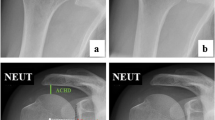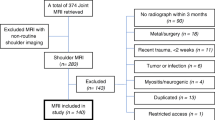Abstract
Cranial translation of the humeral head is related to massive rotator cuff tears; however, it may be unapparent in early-stage tears. The goal of this study was to investigate whether active abduction leads to increased active cranial humeral translation in early-stage tears. We assessed 20 consecutive patients (9 full-thickness supraspinatus tears, 11 posterosuperior tears) using the newly introduced modified active abduction view: acromiohumeral (AH) distance was measured on radiographs acquired during rest and active isometric abduction and adduction tasks with the arm alongside the body. Rest AH was 7.5 mm (SD = 1.53); during abduction and adduction, it decreased to 2.1 mm (95 % CI 1.28–3.01, p < 0.001) and 1.1 mm (95 % CI 0.46–1.65, p = 0.001), respectively. Cranial translation during abduction was more severe in shoulders with posterosuperior cuff tears (∆AH = 3 mm, SD = 1.5) compared to supraspinatus tears (∆AH = 1 mm, SD = 1.6), with a mean difference of 2 mm (95 % CI 0.64–3.58, p = 0.007). Both active isometric abduction and adduction leads to active cranial translation in cuff tear patients. Cranial translation is largest during active abduction. Furthermore, there is significant more cranial translation in posterosuperior cuff tear patients compared to supraspinatus cuff tear patients. Possibly, radiographs combined with active tasks offer new possibilities in diagnosing early-stage rotator cuff tears.


Similar content being viewed by others
References
Bloom RA (1991) The active abduction view: a new maneuvre in the diagnosis of rotator cuff tears. Skeletal Radiol 20:255–258
Chopp JN, O’Neill JM, Hurley K, Dickerson CR (2010) Superior humeral head migration occurs after a protocol designed to fatigue the rotator cuff: a radiographic analysis. J Should Elbow Surg 19:1137–1144
de Groot JH, van Woensel W, van der Helm FC (1999) Effect of different arm loads on the position of the scapula in abduction postures. Clin Biomech (Bristol, Avon) 14:309–314
de Witte PB, Henseler JF, Nagels J, Vliet Vlieland TP, Nelissen RG (2012) The Western Ontario Rotator Cuff index in rotator cuff disease patients: a comprehensive reliability and responsiveness validation study. Am J Sports Med 40:1611–1619
de Witte PB, van der Zwaal P, Visch W, Schut J, Nagels J, Nelissen RG, de Groot JH (2012) Arm adductor with arm abduction in rotator cuff tear patients vs. healthy—design of a new measuring instrument. Hum Mov Sci 31:461–471
Deutsch A, Altchek DW, Schwartz E, Otis JC, Warren RF (1996) Radiologic measurement of superior displacement of the humeral head in the impingement syndrome. J Should Elbow Surg 5:186–193
Goud A, Segal D, Hedayati P, Pan JJ, Weissman BN (2008) Radiographic evaluation of the shoulder. Eur J Radiol 68:2–15
Graichen H, Hinterwimmer S, von Eisenhart-Rothe R, Vogl T, Englmeier KH, Eckstein F (2005) Effect of abducting and adducting muscle activity on glenohumeral translation, scapular kinematics and subacromial space width in vivo. J Biomech 38:755–760
Gruber G, Bernhardt GA, Clar H, Zacherl M, Glehr M, Wurnig C (2010) Measurement of the acromiohumeral interval on standardized anteroposterior radiographs: a prospective study of observer variability. J Should Elbow Surg 19:10–13
Hirooka A, Wakitani S, Yoneda M, Ochi T (1996) Shoulder destruction in rheumatoid arthritis. Classification and prognostic signs in 83 patients followed 5–23 years. Acta Orthop Scand 67:258–263
Keener JD, Wei AS, Kim HM, Steger-May K, Yamaguchi K (2009) Proximal humeral migration in shoulders with symptomatic and asymptomatic rotator cuff tears. J Bone Joint Surg Am 91:1405–1413
Lehtinen JT, Belt EA, Kauppi MJ, Kaarela K, Kuusela PP, Kautiainen HJ, Lehto MU (2001) Bone destruction, upward migration, and medialisation of rheumatoid shoulder: a 15 year follow up study. Ann Rheum Dis 60:322–326
Lehtinen JT, Belt EA, Lyback CO, Kauppi MJ, Kaarela K, Kautiainen HJ, Lehto MU (2000) Subacromial space in the rheumatoid shoulder: a radiographic 15-year follow-up study of 148 shoulders. J Shoulder Elbow Surg 9:183–187
Matsen FA III (2008) Clinical practice. Rotator-cuff failure. N Engl J Med 358:2138–2147
McCully SP, Suprak DN, Kosek P, Karduna AR (2006) Suprascapular nerve block disrupts the normal pattern of scapular kinematics. Clin Biomech (Bristol, Avon) 21:545–553
Nagels J, Verweij J, Stokdijk M, Rozing PM (2008) Reliability of proximal migration measurements in shoulder arthroplasty. J Should Elbow Surg 17:241–247
Neer CS (1972) Anterior acromioplasty for the chronic impingement syndrome in the shoulder: a preliminary report. J Bone Joint Surg Am 54:41–50
Oh LS, Wolf BR, Hall MP, Levy BA, Marx RG (2007) Indications for rotator cuff repair: a systematic review. Clin Orthop Relat Res 455:52–63
Rozing PM, Obermann WR (1999) Osteometry of the glenohumeral joint. J Should Elbow Surg 8:438–442
Sher JS, Uribe JW, Posada A, Murphy BJ, Zlatkin MB (1995) Abnormal findings on magnetic resonance images of asymptomatic shoulders. J Bone Joint Surg Am 77:10–15
Sneppen O, Fruensgaard S, Johannsen HV, Olsen BS, Sojbjerg JO, Andersen NH (1996) Total shoulder replacement in rheumatoid arthritis: proximal migration and loosening. J Should Elbow Surg 5:47–52
Steenbrink F, de Groot JH, Veeger HE, Meskers CG, van de Sande MA, Rozing PM (2006) Pathological muscle activation patterns in patients with massive rotator cuff tears, with and without subacromial anaesthetics. Man Ther 11:231–237
Steenbrink F, de Groot JH, Veeger HE, van der Helm FC, Rozing PM (2009) Glenohumeral stability in simulated rotator cuff tears. J Biomech 42:1740–1745
Steenbrink F, Meskers CG, Nelissen RG, de Groot JH (2010) The relation between increased deltoid activation and adductor muscle activation due to glenohumeral cuff tears. J Biomech 43:2049–2054
Steenbrink F, Nelissen RG, Meskers CG, van de Sande MA, Rozing PM, de Groot JH (2010) Teres major muscle activation relates to clinical outcome in tendon transfer surgery. Clin Biomech (Bristol, Avon) 25:187–193
Umans HR, Pavlov H, Berkowitz M, Warren RF (2001) Correlation of radiographic and arthroscopic findings with rotator cuff tears and degenerative joint disease. J Should Elbow Surg 10:428–433
van de Sande MA, Rozing PM (2006) Proximal migration can be measured accurately on standardized anteroposterior shoulder radiographs. Clin Orthop Relat Res 443:260–265
van de Sande MA, Stoel BC, Rozing PM (2006) Subacromial space measurement: a reliable method indicating fatty infiltration in patients with rheumatoid arthritis. Clin Orthop Relat Res 451:73–79
Weiner DS, Macnab I (1970) Superior migration of the humeral head. A radiological aid in the diagnosis of tears of the rotator cuff. J Bone Joint Surg Br 52:524–527
Acknowledgments
We gratefully acknowledge the work of H. Fraterman for building the experimental setup. The institution of the authors has received funding from Dutch Arthritis Association (grant number 09-1-303).
Author information
Authors and Affiliations
Corresponding author
Rights and permissions
About this article
Cite this article
Henseler, J.F., de Witte, P.B., de Groot, J.H. et al. Cranial translation of the humeral head on radiographs in rotator cuff tear patients: the modified active abduction view. Med Biol Eng Comput 52, 233–240 (2014). https://doi.org/10.1007/s11517-013-1057-2
Received:
Accepted:
Published:
Issue Date:
DOI: https://doi.org/10.1007/s11517-013-1057-2




